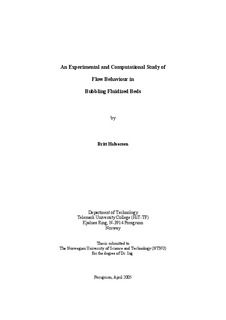| dc.contributor.author | Halvorsen, Britt | |
| dc.date.accessioned | 2007-02-16T10:02:23Z | |
| dc.date.accessioned | 2017-04-19T12:11:03Z | |
| dc.date.available | 2007-02-16T10:02:23Z | |
| dc.date.available | 2017-04-19T12:11:03Z | |
| dc.date.issued | 2005 | |
| dc.identifier.isbn | 82-471-7012-4 | |
| dc.identifier.isbn | 82-471-7011-6 | |
| dc.identifier.issn | 0802-3271 | |
| dc.identifier.issn | 0802-3271 | |
| dc.identifier.uri | http://hdl.handle.net/11250/2437800 | |
| dc.description | Avhandling (dr.ing.) - Høgskolen i Telemark / Norges teknisk-naturvitenskapelige universitet | |
| dc.description.abstract | Experimental and computational studies of bubble behaviour in gas/solid fluidized beds have been performed. Bubble behaviour depends on particle density, particle size and size distribution and emphasis is given to study these effects. Bubble behaviour is also influenced by the superficial gas velocity, excess gas velocity and the relation between particle diameter and bed dimensions. These effects and their influence on flow behaviour are studied as well. Measurements have been performed on a two-dimensional fluidized bed with a central jet. Experiments were performed with two different groups of powders A video camera was used to detect bubble behaviour. The purpose was to verify the calculation of bubble formations on a simple well-defined model. A three dimensional fluidized bed has been constructed and built. A fibre optical probe was used to detect bubbles and their properties. A Labview program has been developed to calculate bubble frequencies, velocities and sizes from the detected signals. Powders with different particle size distributions were used to study its influence on flow behaviour. It was found that bubble behaviour is highly dependent on particle size distribution and that this has to be taken into consideration in the modelling of gas/particle systems. A three-dimensional computational fluid dynamic (CFD) model developed by previous studies at Telemark University College was modified to improve its use in dense particle systems like bubbling fluidized beds. A computational routine was developed to calculate bubble frequencies, velocities and sizes. To obtain realistic bubble shapes and bubble velocities, second order upwind schemes and different flux limiters were included in the code. The code has been modified to prevent unphysically dense packing of solids. A ??witch??to plastic regime at critical packing has been included in the code. Frictional stresses substitute the kinetic and collisional stresses above a specified critical packing. The solid pressure is defined as a function of the solid volume fraction. A routine for solid volume fraction correction was included in the code to stabilize the computations in closed packed regions. An alternative equation for the radial distribution function has been included. Simulations of bubble behaviour in two and three dimensional beds have been performed with different types of powders and different superficial gas velocities. The influence of drag models, coefficient of restitution and number of particle phases has been studied. The numerical results correlate fairly well with experimental data for most of the cases. A computational study of bubble behaviour in fluidized beds with different diameters has been performed by using a CFD code developed at National Energy Technology Laboratory (NETL). The computational results are compared to experimental data presented in literature. Some connections between bubble behaviour and bed dimensions were observed and can be used for further work on the scaling of industrial fluidized beds. Scaling was also performed by using scaling parameters. | |
| dc.format.extent | 3051618 bytes | |
| dc.format.mimetype | application/pdf | |
| dc.language.iso | eng | |
| dc.publisher | Telemark University College | |
| dc.relation.ispartofseries | Doctoral theses at NTNU;2005:70 | |
| dc.subject | Bubble behaviour | |
| dc.subject | Fluid dynamics | |
| dc.subject | Modelling | |
| dc.title | An experimental and computational study of flow behaviour in bubbling fluidized beds | |
| dc.type | Doctoral thesis | |
| dc.type | Peer reviewed | |
| dc.rights.holder | © Copyright The Author. All rights reserved | |
| dc.subject.nsi | 562 | no |
